Auckland Museum has launched its new online collection website. This new site makes over million records freely available, adding many new features in the process. We’re excited to have helped with publishing data from Vernon CMS, including the social and natural history object collection and the Cenotaph military personnel records.
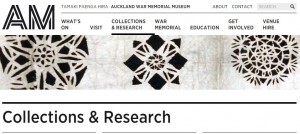
You can read their official press release on the Auckland Museum website: “Auckland Museum takes collection online as part of global legacy“.
Behind the scenes the data in Vernon CMS is sent to Auckland Museum’s bespoke digital content system. This stores data from several applications, providing structured data to power the website and their new collection programming interface. As data is changed in Vernon CMS it is automatically sent to the digital content system via Vernon CMS’ Web Messenger function. This has allowed the Museum to define exactly which files and fields are published. The digital content system then extends and restructures this data to meet public access requirements. Our work has been limited to converting the legacy Cenotaph military records into Vernon CMS and then storing and publishing the collection and Cenotaph data, so it’s exciting to see the new site go live.
The online collection site provides a number of significant new features:
1. The site is a mobile-friendly responsive design.
The layout automatically changes to fit the screen space of the device the visitor is using.
2. Search options now include a wide range of filters to hone in on the records you’re looking for.
For example, if you were looking kiwi specimens you can search for kiwi and then easily narrow down the search to just the birds collection, and perhaps only the specimens that have images.
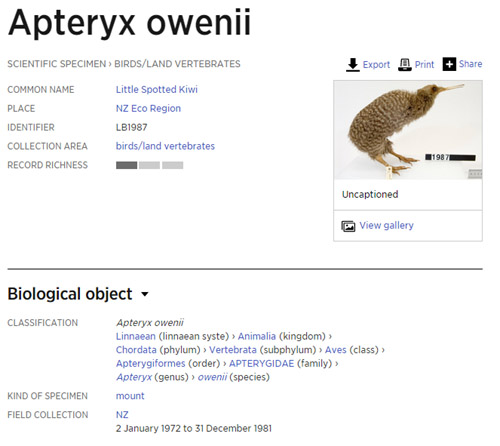
3. Content has been licensed for re-use.
Where Auckland Museum holds the copyright or the material is out of copyright, images are now marked as ‘No Known Copyright Restrictions’ or with a Creative Commons licence. For example, the kiwi specimen in this article has a Creative Commons licence to allow the image to be re-used by others. You can see the original specimen record here: Little Spotted Kiwi, LB1987
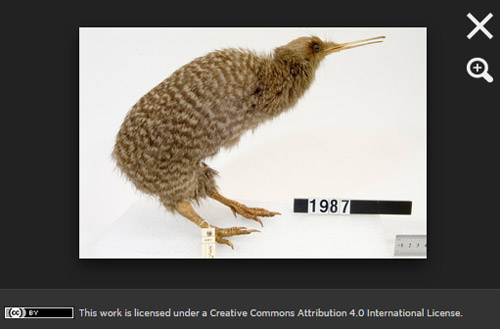
4. Options to download the raw data.
On the search results and record detail page you can now export the data. This is useful if you’re wanting to do further research or analysis and need to keep a copy of the data. For example, I downloaded the data for all of the timepieces the Museum holds in the social history collection (173 clocks, watches etc). I then opened the data in Watson Analytics (IBM’s free data visualisation tool) to see the breakdown of the timepiece collection by production place.
There is a limit of 100 records in the data download which is a bit frustrating. In this example I did two downloads – page 1 with 100 records and page 2 with 73 records – and then combined these into one spreadsheet.
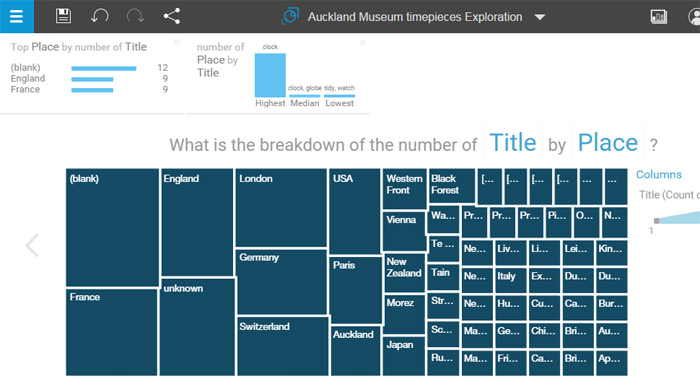
5. An application programming interface (API) to allow developers to work with the full data.
Developers can now register for access to the collection and Cenotaph data. This provides access to search the database in real time, extending the possibilities for research and building third party applications. There’s detailed documentation in the new Auckland Museum API section of the website.
6. The record detail page includes new options for adding tags and linking to related records.
Museum records are never perfect. The volume of objects in the Auckland Museum collection makes the clean-up and improvement of the catalogue records an ongoing process but access to the complete catalogue is still incredibly useful. The record detail page now gives a ‘Record Richness’ indicator to show how complete the record is compared to others in the collection.
Visitors can also now add their own tags to a record to help others with their searches.
Fields with consistent information, like the structured Classification field, provide a jumping off point for visitors to view related records. For example, from this kiwi record a visitor can easily go to all of the specimens for the genus or all of the mounted specimens.
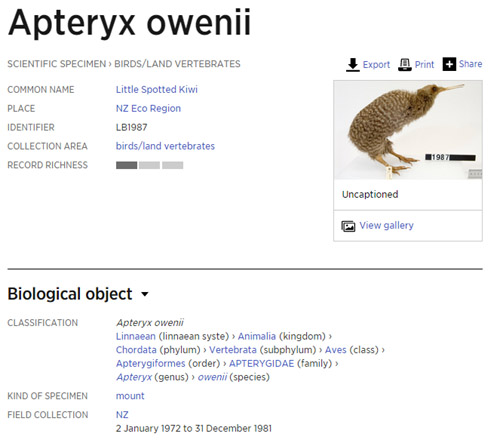
The new online collection site is a great leap forward. You can read the Museum’s summary of what’s new in their updated collections database article.